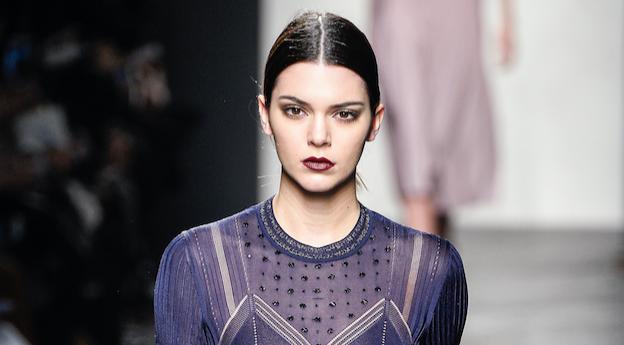Why don't models smile?<
In catwalks, magazine photos and advertisements, models almost always put on a very serious face. Why don't models smile?
Published on Nov 2, 2018 Olivia Lévy LA PRESSEFor people who work in the fashion world, this serious, even sulky, pout of models is a normality.
Photographer Maude Arsenault explains that anything haute couture and designer creation has always been seen in a very elitist way. “Elegance, chic and luxury are not associated with a smiling and cheerful woman. In the first 20 years of my career as a fashion photographer, from the moment there was a smile, it became a commercial, low-end image, she says. The only campaigns where we saw women smiling were for very accessible clothes or brands.”
An opinion shared by Madeleine Goubau, lecturer at the ESG UQAM School of Fashion. “The serious pout contributes to the feeling of inaccessibility of luxury, because a smile is sympathetic and inviting.”
According to Marie-Ève Émond, creator of Betina Lou, not smiling is an implicit code in the fashion industry that is difficult to break. "In our photos, we try to make our models look natural, neutral, without being snobbish or inaccessible," says the designer. We often make jokes during photography sessions that if the model strikes a certain pose or smiles, we say that it looks too much like the Sears catalog,” confides Marie-Ève Émond.
Nadya Toto, designer of the brand of the same name, believes that high-end clothing collections can be considered works of art, and that her work should be taken seriously.
"It's not the smile that we want to see, but the clothing above all, and it's always been like that."
Historical reasons
There are historical and cultural reasons for this absence of a smile. "Charles Frederick Worth (1825-1895), the first great couturier in the history of fashion, considered the mannequin as a "support" which served only to present the clothes and was not considered a person", explains Luca Marchetti , professor of fashion theory and culture at the ESG UQAM School of Fashion. He tells a revealing anecdote: “At the beginning of the 20th century, the famous French fashion designer Paul Poiret gave an interview in which we wanted to ask his models questions. Furious, the couturier then interposed himself between the models and the journalist, replying: "Don't talk to them, they don't exist!" It shows how the mannequin had a purely functional utility, ”says the professor.

On #MosaicMonday, @VernYipDesigns displays how to install mosaic tiles from floor-to-ceiling to create a one-of-ak… https://t.co/zgFroqKFkY
— Emser Tile Mon Feb 25 22:01:00 +0000 2019
It was only later, in the 1950s, at the time of Christian Dior, that we observed a change. “Culture is changing with the explosion of media based on the image which is fundamental and color photography. Haute couture and ready-to-wear need to communicate a personal identity. The models are starting to smile and express their personality,” says Luca Marchetti.
Ready-to-wear subsequently loses its “haute couture” value and needs to have an identity in order to shine. It is therefore now necessary to communicate a luxury dimension that clothing does not have. So who says luxury says inaccessible. “Clothing then promises an imaginary world. Luxury in Latin, luxus, means superfluous, deviation, estrangement from common and everyday things. We sanctify the clothes, and the models do not consider us, we are not part of their world, hence the absence of a smile, the haughty air and the distant look, ”sums up Professor Marchetti.
The editor of fashion magazine Dress to Kill, Stéphane Le Duc, thinks this absence of expression helps to emphasize the clothes. Even on social networks, the many bloggers and influencers are photographed without smiling, with some exceptions.
“There is a desire for anonymity. Besides, we hardly know the models anymore, they are anonymous, serious, neutral.
It evokes the 90s, where models were superstars; the great era of Cindy Crawford, Linda Evangelista, Claudia Schiffer... “When you look at photos of Linda Evangelista, she is smiling, fulfilled. These models were voluptuous and the smile followed, since they had personality. Afterwards, there was a headwind, the models faded away and the smile disappeared.
There are exceptions. In the parades of Jean Paul Gaultier, Sonia Rykiel and Diane Von Furstenberg, the models embody the joy of living. “American designer Diane Von Furstenberg instructs her models to smile. She has an aesthetic that highlights the strong and assumed woman, a woman who has fun, it's important, because it's her brand image, ”underlines Madeleine Goubau.
wind of change
As fashion works in cycles, the smile is slowly coming back. Arielle Day, model agent at Folio, assures that she tries to break this stereotype.
“It is changing. We ask our models to show their personality, to smile, to be spontaneous, to laugh, both in magazines and in fashion shows, because we want to show a less serious side of fashion.
The photographer Maude Arsenault also thinks that the smile invites itself more in the campaigns. Some of his recognized colleagues show more smiling women, as do some brands. "We put forward new female models, fulfilled, liberated, more authentic women, and models from diversity, we feel that there is a change."


 Tags:
Tags: Prev
Prev







